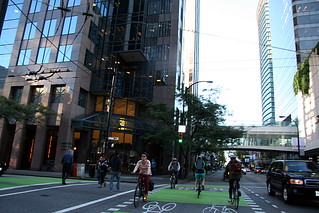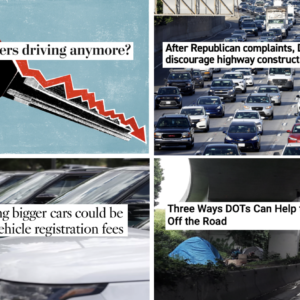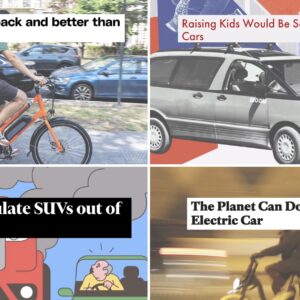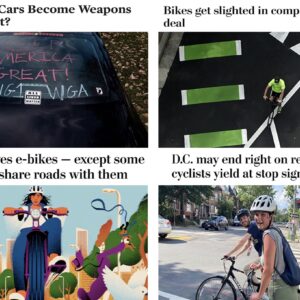
(Photo: M. Andersen)
This week’s Monday Roundup is sponsored by the 15th annual Worst Day of the Year Ride, coming your way on February 14th.
Here are the bike-related links from around the world that caught our eyes this week:
Business turnaround: Five years after Vancouver BC’s downtown business group spoke against removing parking for a protected bike lane network, the group’s executive director has reversed his position, saying “it’s obvious that separated bike lanes [are] working.”
“Mechanical doping”: Hidden electric motors are the latest way to cheat in a bike race, apparently.
Pronto bailout: Seattle (home to a mandatory helmet law and a downtown surrounded by hills, it’s worth noting) is considering a $1.4 million purchase of its little-ridden, money-losing nonprofit bike-share system.
Uber safety: The hail-a-ride company is testing ways to track its dangerous drivers.
Cards Against Urbanity: The party game for city wonks was “on every planner’s wish list this past Christmas.”
“Minimum grid”: The coinage by Toronto-based advocate Gil Penalosa is a major rallying cry as the city considers a protected bike lane network built over the next two years.
Population boom: “We have a crunch coming,” warns Ashok Sinha of the London Cycling Campaign. “Cycling is one of the ways we’ll be able to keep this city moving.”
Commute inequality: In the Bay Area, low-income commute times have nearly doubled since 2010, while middle-class commute times are flat.
Housing infill: Increasing the number of homes in neighborhoods that are already bikeable is just as important as spreading bike infrastructure, says Seattle Bike Blog.
Traffic jam museum: Belgium’s national rail system has launched a creative ad campaign: satirical advocacy to honor “the Belgian traffic jam” with a World Heritage Site.
Advertisement
Vancouver bike lanes: The Washington city has begun using solid green bike lanes and dashed green mixing zones in some spots, much like Portland.
Party bike: Vancouver is also about to get “Couve Cycle,” its first 13-seater downtown sightseeing pedal vehicle.
Tolerating congestion: The Federal Highway Administration wants more states to scrap the “level of service” system that often makes free-flowing traffic (rather than, say, shorter trips) the top policy priority.
Snowy plazas: Wired Magazine helps popularize the concept of the “sneckdown” that reveals potential street changes in heavy snow.
Mandatory stops: South Dakota has killed a law that would have required people biking to pull over and stop if a faster vehicle overtook them.
Bathroom map: A New Zealand road safety campaign is hanging maps showing traffic crash locations over urinals.
L.A. transit: Streetsblog LA does a nice job slashing up a scary Times headline about allegedly declining transit use.
Parkingless cars: Mother Jones devoted a cover story to the potential for driverless cars to dramatically reduce parking demand.
Blizzard priority: Why does even a city where most people don’t drive still shovel streets before sidewalks?
Fatal homelessness: Seattle Bike Blog grapples with the parallels and links between living on the street and biking on the street.
If you come across a noteworthy story, send it in via email, Tweet @bikeportland, or whatever else and we’ll consider adding it to next Monday’s roundup.
— Michael Andersen, (503) 333-7824 – michael@bikeportland.org
BikePortland can’t survive without paid subscribers. Please sign up today.





Thanks for reading.
BikePortland has served this community with independent community journalism since 2005. We rely on subscriptions from readers like you to survive. Your financial support is vital in keeping this valuable resource alive and well.
Please subscribe today to strengthen and expand our work.
Seattle bike share program is insolvent and requires a $1.4 million bailout from the city council.
Here is an interesting commentary.
http://www.seattletimes.com/seattle-news/bike-shares-failure-deflates-seattles-self-image/
Perhaps something can be learned in Portland from their problems. There must be commonalities.
I think the thing to learn is that mandatory helmet laws aren’t good for bikeshare systems or bicycle mode share in general.
That seems to be the experience. I wouldn’t ride a bike without a helmet, particularly on streets shared with motor vehicles, but bike share does attract a lot of casual users who may not carry a helmet. I know Melbourne’s (Australia) bike share hasn’t been widely used, probably due to the mandatory helmet law, which is rigorously enforced. In Portland, most people wear helmets, but I am not sure that most bike share riders will. When I lived in NYC, I used Citibike a lot, and always wore a helmet, but that’s me, not most Citibike users.
I trust you also wear a helmet when you enter a motor vehicle, since per hour of use a motor vehicle is 12% more likely to cause you a traumatic brain injury than riding on a bike. Come to think of it, you’re almost twice as likely to experience a brain injury while walking than while cycling, so surely you wear a pedestrian helmet.
(From Seattle): There are lots of similarities between Seattle and Portland that should make Portland wary. However, there are some particular causes for Seattle’s struggles that Portland might avoid:
– The bike share system is split between a downtown-centered system and a UW-centered system a few miles to the north. The (smaller, less station-dense) UW-centered system is not performing well, and accommodating both reduces station density everywhere. I think Portland is starting with more bikes and more stations; if it goes with a single continuous service area it can provide better service downtown than Seattle does.
– Seattle’s CBD is ludicrously steep; getting between downtown and Capitol HIll or First Hill is a serious climb, also.
– There are some plateaus; some of them (Pioneer Square, SLU) have tons of construction going on. That means both street disruptions and (temporarily) fewer people actually using the buildings in the area. You’d expect the system to become more popular in a few years even just on the basis of those buildings filling in.
– You’d also expect the system to become more popular in a few years on the basis of imminent subway station openings in Capitol HIll and the U District (i.e. last-mile-from-regional-transit usage will become more popular).
– The bike network within the downtown-centric Pronto service area is extremely fractured. Crossing I-5 between downtown Seattle and Capitol Hill or First Hill is sort of like crossing the Willamette, except that it’s set in the side of a steep hill and all the bike routes across it are mostly terrible. There are a few protected bike lanes but they’re pretty isolated from routes across I-5, or routes into downtown from the north and south.
– The non-profit running this thing was joined at the hip to Children’s Hospital. This distorted both planning (it’
The planning and financial acumen of the non-profit in charge is questionable, considering that it’s becoming insolvent already following a year of performance that nobody can really say is unexpectedly bad. Though there are reasons to hope Portland can do better, hope and enthusiasm are no substitute for rational scrutiny.
(accidental post in the middle of editing the last bullet-point). Continuing: the relationship with Children’s Hospital distorted both system planning (Children’s is located northeast of UW; putting a station at Children’s essentially made the UW-centered satellite necessary) and advocacy (Children’s is one of the biggest cheerleaders of our all-ages helmet law, and trying to provide helmets has proven a surprisingly large expense for the system, in addition to being a deterrent to usage). A system without their influence could have stayed solvent for at least a little longer; first by focusing on station density in areas where success is possible, second by negotiating with Seattle leaders to have helmet law enforcement suspended.
Al from Seattle…thanks for the info.
“…– The non-profit running this thing was joined at the hip to Children’s Hospital. This distorted both planning (it’ …” al diamond
Can you explain more about the hospital’s involvement with Seattle’s bike share? Is the hospital helping significantly to fund the bike share, and does that account for it, having been as you say…running the system?
Seattle Times story gives considers some good possible reasons that city’s bike share program isn’t flourishing. Among those reasons given are the city’s in some areas steep terrain, poor cycling infrastructure on key routes throughout the city, and of course, rainy weather. The story’s writer also wonders
“… The city wants to grow the bike share to save it. OK, if we’re going to have a bike share, it is nuts that there are no stations in places like Fremont or Wallingford. …”
Someone else reading here may be able to make more of the mention of those streets or neighborhoods’, whichever they are, relevance to potential success of Seattles’s bike share system.
Seattle could fairly easily get some idea of how the mandatory helmet use law may be affecting use of the bike share bikes, by perhaps having city council consider a three or six month experimental waiver of the helmet requirement. Say, from June through November to cover a period of easy and tough weather. If bike share use jumps, the city could consider a permanent waiver of the helmet use law.
Children’s was a major early sponsor.
As for the Times’ comments… I don’t get why they’d mention Wallingford, which isn’t particularly dense or bike-friendly. Part of Wallingford is along the Burke-Gilman Trail (a very popular railroad-grade trail) between Fremont and UW, but its main business district and center of gravity is way uphill from there. Fremont is a bit denser, more people work there, its business district is much closer in distance and, critically, elevation to the Burke-Gilman, it has a popular Sunday market that lots of people bike to, and there are always lots of bikes on the streets because the Fremont Bridge collects riders from all over north Seattle (so you don’t feel so alone where the infrastructure is lacking). Because of its low elevation, it’s pretty easy to ride there from UW or downtown.
There are problems with going to Fremont, though. One of the popular routes between Fremont and downtown is through a long, city-owned parking lot along Westlake Ave, but there’s a lot of tension and controversy over that practice as well as the cycletrack that will be finished there later this year. Tacitly or overtly encouraging Pronto users to ride down the parking lot (now also a construction zone) would have thrown gas on the fire with every group involved. Furthermore, putting in the stations to connect Fremont to UW and downtown would have stretched the system even thinner than it is. And the bikey core of Fremont isn’t really all that big or dense, and it’s relatively far (by bike-share distances) from other bikey places. Incremental extensions east from Capitol Hill, or infill in First Hill or the International District, might actually be better.
I bet the Times doesn’t say a word about helmets or Children’s.
Al, link to the S Times story is in both the Roundup and in Doug’s comment up top. Actually, it’s a staff columnists’ piece rather than a straight news report story, which may in part account for the writer’s selectivity in choosing what things to mention about the city’s bike share. I thought it was a decent, thoughtful piece. You’re right, he didn’t mention the hospitals involvement or what bearing mandatory helmet use may be having on people deciding to use bike share in the city.
I feel that use of bike helmets is generally a good idea, such as in traffic, but that laws mandating adults wear them (Oregon does the 16 and under thing.), poses problems, and not just for bike share.
Roads are insolvent and require daily bail outs.
Basic public roads (as well as other functional public spaces) provide a public benefit so broad it’s not even worth trying to measure it.
Except when those roads are paid for by the public but exclude members of the public not using automobiles.
mechanical doping: it’s true, they found a motor in her bike: http://www.cyclingnews.com/news/uci-confirms-motorised-doping-uncovered-at-cyclo-cross-world-championships/
Its utter BS! these so called “motor’s” don’t exist. lets just look at the facts here, It took Lance Armstring years and millions of dollars to hide his doping program. All from drugs that already exist and make tons of money outside of bike racing.
It took Shimano years of R&D & testing and millions in investment to develop DI2 and by the way I tested one of the first DI2 designs from Shimano back in 2002 and was involved in the early R&D. It took them almost 15 years to develop DI2!
Now fast forward to the present, lets say that “someone” has developed a motor the diameter of a dime about a foot long and weighs less than a pound.
Just the material costs of producing it would be astronomical… It would need to be a mix of carbon fiber components and aluminum. making one usable sample of such a motor would cost 10s of thousands of dollars not including the cost of designing such a motor.
Where did that money come from?
Does anywhere really believe that a no name U23 racer with minimal sponsorship somehow got in touch with a designer, engineer and machinist and came up with the 100s of thousands of dollars to develop and produce such a motor?
So that leads us to believe that some wealthy [silent] nefarious sponsor spent 100s of thousands on developing a motor that would have to be disposable, extremely light weight and reasonably produced in pure secrecy while being 100% unavailable to the masses… all secretly installed in a completely anonymous manor on a racers bike that didn’t even use it? and didn’t even come close to the podium?
Sorry I don’t buy it. There is not a single investor or sponsor in existence that is “Not in it for the money” and they are not going to invest in R&D in such a random way with such a low chance of success.
And they would be foaming at the mouth to get it into the retail market to make money on said investment. Because the ROI on a handful of racers winning races compared to what they would make in the retail world selling to the public would be overwhelmingly small.
remember all the “doping” drugs already exist in the controlled substances market and make money hand over fist outside the business of bike racing. PEDs are an extremely small slice of pie in the pharmaceutical industry.
Ah you can buy such a motor here is the web site http://www.vivax-assist.com/en/produkte/vivax-assist-4-0/vivax-assist_4-0.html
uh huh… go ahead try and order one of those 4 lbs units that hilariously are supposed to add 200 watts to your pedal stroke.
And as I stated before these so called doping “motors” don’t exist… read the review from Bikeradar
http://www.bikeradar.com/gear/category/bikes/electric/product/review-gruber-assist-conversion-kit-42720/
“For such a small motor, the Gruber makes a surprising amount of rather high-pitched noise. This would count it out for any rider looking for bit of stealthy assistance in a road race. ”
Also as stated the “sizing” issue:
“The Assist Kit can be fitted to most steel and aluminum frames (but not carbon fiber ones) with seat tube diameters of 30.9mm or 31.6mm, as long as the seat tube is centered over the bottom bracket.”
That pretty much rules out most if not all racing frames because seat tube ID on (Carbon fiber frames) is rarely consistent or even close to that large of a diameter. manufacturers either bore out the seat tube to a maximum depth for the post or in higher end production will form the tube with just enough length for seat post but still need to do a finish bore for proper fit of seat posts. And as with many steel and aluminum frames there is a very small “breather” hole between seat tube and bottom bracket which this system would not fit through.
in reality this system only fits a very few select or custom made frame or their own frames which they conveniently sell on that website as well.
But there is still that weight of 4 pounds and the big seat bag that holds the battery… hum, is it worth a pro to turn their 17 pound (average weight) race bike into a 21 pound weight? seriously doubt it.
I’ll just leave this here…
http://cyclingtips.com/2015/04/hidden-motors-for-road-bikes-exist-heres-how-they-work/
These motors exist, you can buy them, they are in bikes, and they work. Plenty of video demonstrations online.
The motor is sized to one of the standard diameters for seatposts.
For a concealed installation, a small battery would be hidden in the seat tube or the downtube. Total weight would be about 1.5 kg. Minimum legal weight for race bikes is 6.8 kg, modern high end racing bikes are already easily built to <6 kg so they need to have weight added to be legal. A motor doped bike could easily be only 1 kg heavier than the legal minimum.
Newer versions are quieter. Wouldn't be heard in the bedlam of a cyclocross World Championships, or when a rider on the road gets a gap and goes on a solo break.
To cheat in a race, just 100 watts for 15 minutes would be ample. The cheater would only use the motor to get a good lead at a critical moment.
For example, the climbs on a typical cyclocross course are a couple of minutes in duration and the top U23 women are probably putting out 450 watts for those two minutes. So if one of them has an extra 100 watts from a motor, that is 450 + 100 = 550 watts and she'd blow the others away. More likely, dial your own effort back, do 400 + 100 = 500 watts, beat the others up the climbs to a less-blatant degree, and use saved extra energy to hold those gains on the rest of the course.
Fortunately, motor doped bikes are not hard to detect, and the scanning (they scan the bikes, then xray any suspicious ones, finally remove the seatpost and cranks to confirm) is becoming widespread. Scanning started with men's World Tour road races. Now in top level cyclocross, will start in top-level women's road too.
As your link shows the motors DO IN FACT exist.
While you may have an authentic point about consumer grade motors being loud, lower power, lower range and any of a variety of negative attributes the simple fact of the matter is that electric motor technological advancement is accelerating AND racing-grade equipment is always better than consumer-grade equipment especially in the bicycle market.
The vivax Assist is running in the $4,000 range. If yoy have economic motivation to win “at any cost” realistically it is no small stretch to imagine getting a custom power unit made by Electronics Engineering undergrads who can tune it to do whatever you want…. for a price.
Even the batteries can be hidden inside the frame: individual Li-ion cylindrical cells in a compatible frame segment or custom (expensive) flexible Li-FePO4 batteries hidden anywhere.
Torque sensors could easily eliminate the need for any external controls.
It all comes down to cost. The technology has existed for years despite your disbelief. Its lack of deployment is a matter of absurd expense in the past that is only slightly less so now.
I’m really looking forward to more people “cheating” on their way to work every single day. I can only hope that cheating in a race becomes popular enough to drive the price down to less than a used hundai.
If it’s true, what a good way to sell E-bikes to vain American sport riders who don’t want to admit using one!
The cycling news article says they hide the motor in the frame and they now have the technology to detect them. Well didn’t the weight give it away? And if the weight didn’t give it away; WHERE CAN I BUY ONE?
I had an e-bike and was proud to use it instead of my car. It cut my car use about 80%. You want less cars on the road? Everyone who reads this blog should put an e-bike on their radar. Maybe not the bike purest, but for most car dependent people the e-bike offers a very green alternative to cars, buses and MAX.
I know ebikes are in widespread use in Japan and I hear they are a fast-growing market in Europe. I’m not entirely certain, but I think the reason they have not caught on in the US (yet) is that we constantly harp on the alleged danger of venturing out onto our roadways without a padded steel cell.
On the bright side, I am starting to see more ebikes every week. It gives me a smile to see grandpa and grandma rolling along with smiles at speeds I’m certain they could not have attained without an assist. Good for them, good for everyone. I particularly enjoy seeing them out on the roads between the city and the suburbs.
Cards Against Urbanity: where can you buy it?
Vancouver BC business group about face – can we get a comment from Sarah Holliday/28th Ave/Staccato Gelato?
http://bikeportland.org/2014/04/29/28th-avenue-update-a-business-owner-speaks-out-105251
Blizzard priority: I’ve only seen one city that plowed their snow into the middle of the street… it was really cool…
That Mike Brown guy in London! Can we get one of him here?
“Those who are critical of [cycling infrastructure], I have to tell you, I think you’re wrong.”
Impressive political assertiveness right there.
As of Sept 2003, property owners are legally liable to keep adjacent clear of snow.
Adjacent sidewalks….In NYC.
Before 2003 property owners were responsible for maintaining sidewalks, including clearing them of snow. The city could fine property owners who failed to do so. In some cases the city would rebuild the damaged sidewalk and send the property owner the bill. But if the sidewalk was in disrepair or covered in ice and someone fell, the city got sued. Not the property owner. The law changed in 2003 to shift liability to the property owner who was already responsible for maintaining the sidewalk. The impetus for the change was that in the three years before the liability shift NYC paid out $189 million in claims.
http://www.nytimes.com/2003/10/05/realestate/your-home-sidewalk-liability-hits-home.html
If nothing else, then at least they clear the streets in NYC.
It’s downright shameful how Portlanders treat their streets and sidewalks as storage space for snow, ice, junk cars, tarped-over dirt mounds for long-stalled garden projects, and overgrown landscaping.
Storage space for snow? Portlanders store snow?
If you’ve got any to spare, I’m sure my kids would like it. Can you deliver?
FHA level of service article links to the wrong place
Hey, Michael: the link under “Tolerating congestion” is wrong. Might want to fix it (I’d like to find that article, myself!). Thanks!
Thanks – fixed.
I’m thrilled to see the formal beginnings of the death of level of service. This bugaboo has been the bane of sensible development and transportation for decades. It’s typical that California is leading the charge by changing the CEQA. Interestingly enough, this change appears to have been started by a stalled public transit project in San Francisco that was held up by CEQA even though it would have reduced car trips simply because the standard was LoS.
Motor heads hate it, but the best way to increase cycling (and transit ridership) is to allow the roads to be congested. Induced demand works in every direction.
Me too, but I’m skeptical that it will take real effect any time soon. I’ve reviewed three EIRs in the last six months and the reality is that they only make mention of the change briefly before they head into the tables of LOS impact. Why? Because nobody knows how to do anything differently than they’ve been doing for years, and the biggest notable negative impact of the new developments that promise so much revenue to cities is that they will create more and more traffic blockages.
As we enter Super Bowl week here, I can only reflect on the fight we had against the stadium being built without adequate conservation of the creek and the MUP next to it. We proposed three alternatives to the layout that would theoretically have prevented the bike trail closures and incredibly dangerous detour that is now commonplace. (For some history, the FEIR is here: http://santaclaraca.gov/Home/ShowDocument?id=12789 – note that it says that traffic impact to bicycling on the trail will be insignificant, and that Tasman would remain open to pedestrians and bicyclists – both are lies). Search for “San Tomas Aquino Creek Trail closures” for more info.
The 49’ers representative said – and I quote: “the 49’ers simply aren’t made of money, and we can’t afford to spend a million dollars to build you a new bike bridge.” As soon as the stadium opened they leased the Great America overflow parking lot for $12M, where Safeway now sponsors the “Faithful Mile”, which is basically concession stands competing with tailgate parties held on the actual bike path. Fast forward to today, we did petitions and the like, but the only real leverage would come from an injunction stemming from a lawsuit, and 1) who has the kind of money to fight a city attorney backed by NFL lawyers, and 2) would you be brave enough to have your name and address publicized as someone who helped prevent the Super Bowl from coming to your city… to accommodate bicycle commuters?
Sorry, I digress, but I had to vent. Please forgive me.
The reality we still see is that money talks and EIRs are a pile of BS that most people don’t have the patience to parse. We saw that here in 2009/10, and we see it now in 2015/6 as the next stage of stadium super-development continues, funded by the likes of Joe Montana and a billion-dollar baby I won’t name. Some of the new plans offer pedestrian malls in the middle of them (to accommodate bicycles??), and overpasses into parking structures so that people can walk and bike underneath them – but I’ve seen nothing to align with our master plan to address safe access to the new (mixed-use) developments.
Sigh. But alas, it gives one a glimmer of hope… the same gift Delaware gave me when they were the first to ban new “Share the Road” signs. 🙂
The Mother Jones article on parking read too much like an advertisement for Google/Uber robo cars. Seems like cheap cyber taxis will just congest cities with circling robo-ubers. The article gives only short shrift to the induced demand. It also ignores a shift from transit/bike/walk and walkable density. If it’s just alt modes folks shifting to Goog-ubering, how does that help cities?